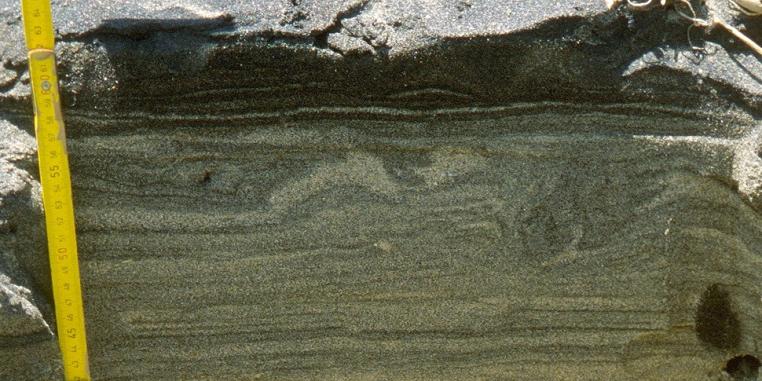
Ollantaytambo Formation: a probably arc-derived volcaniclastic succession of Cambrian to Ordovician age in the Cordillera Oriental of southern Peru
Heinrich Bahlburg (1), Victor Carlotto (2), José Cárdenas (2), and Eva Westervoss (1)
(1) Geologisch-Paläontologisches Institut, Westfälische Wilhelms-Universität, Corrensstrasse 24, 48149 Münster, Germany
(2) Departamento Académico de Geología, Universidad San Antonio Abad del Cusco, Cusco, Peru
Introduction
The Ollantaytambo Formation is exposed extensively in the vicinity of the Inca archeological site of Ollantaytambo located in the Cordillera Oriental of southern Peru. This lithostratigraphic unit was first mentioned by Marocco (1978) who described the 'Serie de Ollantaytambo' as a Cambrian to possibly Early Ordovician succession of quartzites, ignimbrites, tuffaceous, partly dark shales, and sandstones of at least 1000 m thickness. Until today no fossils were found in the rocks. To our knowledge the Ollantaytambo Formation represents the only evidence of syndepositional volcanic activity in the Early Paleozoic of the Cordillera Oriental of southern Peru and northern Bolivia. It is therefore of key significance for the interpretation of the plate tectonic evolution of the Early Paleozoic Gondwana margin in the northern Central Andes.
Stratigraphic relationships
The base of the Ollantaytambo Formation is not exposed. At the top it is overlain concordantly by Ordovician conglomerates and sandstones of the Veronica Formation, which, in turn, is separated from overlying finer grained sandstones and shales of biostratigraphically dated Arenig-Llanvirn age (San José Formation) by an unconformity (Carlotto and others, 1996). Furthermore, Carlotto and others (1996) indicate the presence of an unconformity in some localities between the Ollantaytambo and San José formations where the Veronica Formation is missing. However, this contact we now interpret as a duplex structure within the Ollantaytambo Formation related to the Tertiary Andean deformation in an otherwise conformable stratigraphic succession of the Ollantaytambo and Veronica formations. However, there may be some syndepositional scouring at the base of the Veronica Formation which appears to represent an up to 500 m thick and c. 10 km wide complex of stacked channels. In the continued absence of biostratigraphically indicative fossils the Ollantaytambo Formation has to be considered as Early Ordovician or Cambrian-Early Ordovician in age.
Lithology and Geochemistry
The most notable unit within the Ollantaytambo Formation is a ca. 100 m thick hydroclastic breccia which constitutes the foundation on which the Ollantaytambo archeological site has been built. The breccias occur above an at least 100 m thick succession of relatively quartz-rich sandstones and interbedded thinner shales and is associated with green shales which probably represent redeposited tuff. The breccias consist of a recrystallized former glassy groundmass with angular mafic clasts of highly variable size, but not larger than c. 6 cm. Most of the clasts show chilled rims indicative of the extrusion of hot magma into ambient water. The breccia is overlain by green coloured fine grained volcaniclastic sandstones, siltstones and shales which grade into quartz-rich sandstones and shales some of which show normal grading indicative of deposition from turbidity currents.
The petrographical and geochemical study of the different lithologies of the Ollantaytambo Formation is presently under way. First results of the geochemical analysis of the breccias, of individual larger hydroclasts contained in the breccias as well as of the associated tuffs shows that these rocks are the product of calc-alkaline basaltic to andesitic volcanism which at least in parts took place subaqueously. Chondrite-normalized element patterns show a moderate enrichment of the LREE with LaN/YbN ratios of 7-14, and a weak Eu anomaly. Pronounced negative Nb and Ta anomalies are considered indicative of a magma evolution in an arc environment.
In contrast to this, the overlying epiclastic sandstones and shales are compositionally relatively mature and have geochemical features reflecting upper crustal sources.Conclusions
The Cambrian-Ordovician basin in the Cordillera Oriental of southern Peru and northern Bolivia has been variably interpreted as an aulacogen, a back-arc rift or a passive margin (Sempéré, 1995; Gohrbrandt, 1992; Keppie and Ramos, 1999). These interpretations were mainly based on regional considerations and the compositional maturity, large areal extent and considerable thickness of the Early Paleozoic sedimentary rocks in the Cordillera Oriental. Our new and still preliminary data indicate the presence of an active Cambro-Ordovician volcanic arc in this region. In view of the limited exposure and stratigraphical range of the volcanic rocks of the Ollantaytambo Formation this arc may have been of only limited spatial and temporal extent. However, it may alternatively represent a northern extension of the Famatinian arc system in the southern Central Andes and thus form part of a large scale plate tectonic feature.
References
Carlotto V., Gil W., Cárdenas J., and Chavez R. 1996. Geología de los cuadrangulos de Urubamba y Calca, hojas 27-r y 27-s 1:100,000. Instituto Geológico Minero y Metalurgico Boletin 65, Serie A: Carta Geológica Nacional, 245.
Gohrbrandt K.H.A. 1992. Paleozoic paleogeographic and depositional developments on the proto-Pacific margin of Gondwana: their importance to hydrocarbon accumulation. Journal of South American Earth Sciences 6, 267-287.
Keppie J.D. and Ramos V.A. 1999. Odyssey of terranes in the Iapetus and Rheic oceans during the Paleozoic. In: Ramos V.A. & Keppie J.D., eds., Laurentia-Gondwana connections before Pangea. Geological Society of America Special Paper 336, 267-276.
Marocco R. 1978. Un segment E-W de la chaîne des Andes peruviennes: la déflexion d'Abancay. Etude géologique de la Cordillère orientale et des hauts plateaux entre Cuzco et San Miguel, sud de Pérou (12°30'S à 14°00 S). Géologie des Andes péruviennes, Travaux et documents de L'O.R.S.T.O.M. 94, 195 pp.
Sempéré T. 1995. Phanerozoic evolution of Bolivia. In: Tankard A.J., Suarez-Soruco S., and Welsink H.J., eds., Petroleum basins of South America. American Association of Petroleum Geologists Memoir 62, 207-230.
Bahlburg, H., Carlotto, V., Cárdenas, J. & Westervoss, E. (2002): Ollantaytambo Formation: a probably arc-derived volcaniclastic succession of Cambrian to Ordovician age in the Cordillera Oriental of southern Peru. V. International Symposium on Andean Geodynamics, extended abstracts, 69-71, Université Paul Sabatier, Toulouse, France.

